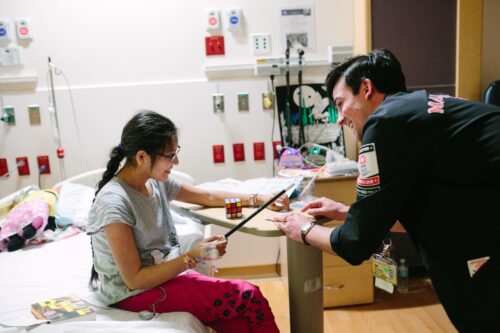
By Judy Bross
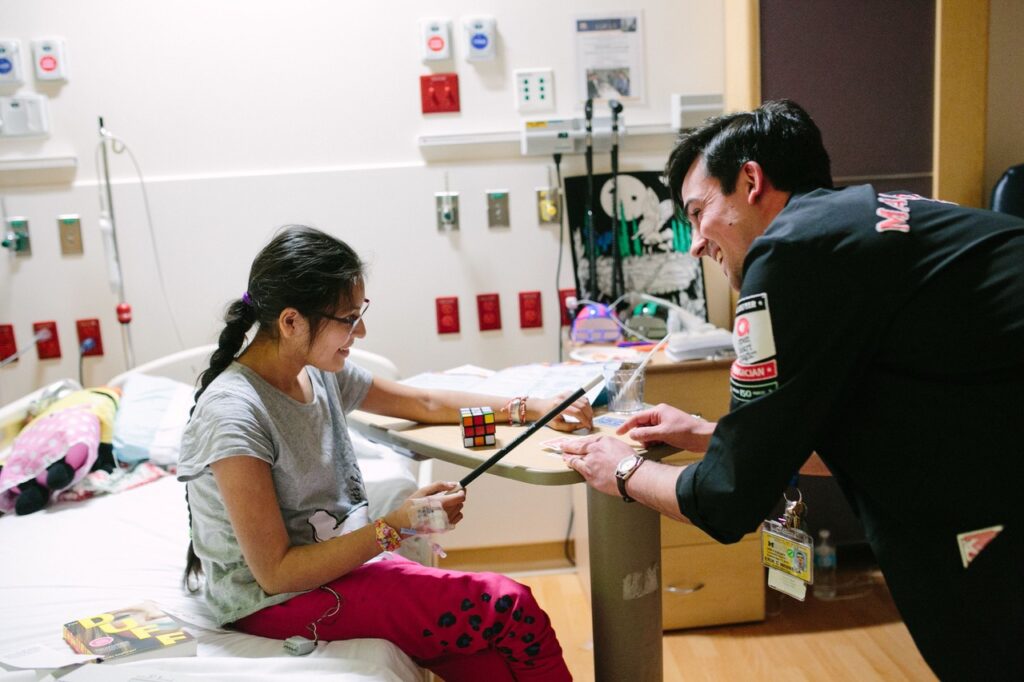
“With wands in hand and magic in heart,” Open Heart Magic and their volunteers fill hospitals with happiness. Learning tricks to put up their sleeves, sleight of hand secrets, and much more magic, young patients are inspired to face serious illness with courage and confidence. Founded in Chicago and serving over 6,800 critically ill children at 12 different hospital centers, Open Heart Magic has 85 hospital-trained magicians. We spoke recently with Mike Walton, Founder and Executive Director of Open Heart Magic, Eric Steigerwald, Senior Director of Marketing and Program Development, and Lexi Gallopoulos, Director of Donor Relations and Fundraising, to learn more about their joy-making organization and how they came to the non-profit world.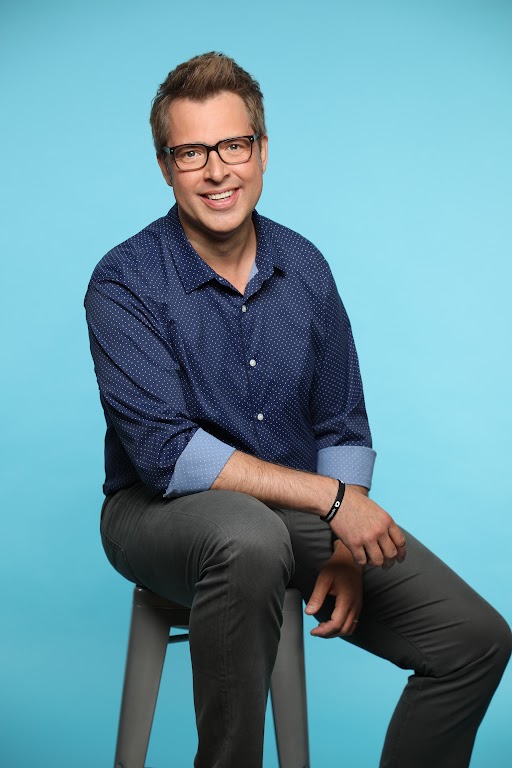
Mike Walton
WALTON: I grew up in Lorain, Ohio – a very diverse steel and auto-manufacturing town. I went to Kent State undergrad and joined the Peace Corps to help businesses organizations transition to the market economy in Estonia. I then became a Peace Corps trainer for the new group of volunteers teaching best practices on how to be effective in regional development in this unique environment. I went to Kellogg for my MBA, then the Internet company I was working for was shedding employees through stages of layoffs. While I made the cut, I knew it was time to leave and started trading futures and wanted to volunteer. I taught myself sleight of hand and close up magic, at the same time David Blaine was on TV doing street magic. I thought kids would love to experience this. So that’s what got me into the hospital to start performing for kids.
After several months of doing magic with kids in all parts of the hospital, I learned that kids love routine, and when you break that routine, which disease does, there’s stress. Then the child goes to a children’s hospital, and the needles, pain and treatments that are critically important for a child to get better, they can create fear and sadness in a child. And this can weaken a child when they need to be at their strongest – they need to tackle the disease and engage in their treatment.
I also learned that from a parent’s point of view, having a child in a hospital is the worst thing that can happen. It’s their worst fear and they’re scared and stressed. I remember early on when I worked with a 9-year boy and his father followed me out of the room and stopped me. I thought “well this is new” but he was there to thank me for helping his child laugh for the first time. I knew something meaningful was here so I started Open Heart Magic (OHM) to reduce this stress and fear, help them laugh again and get stronger and get better.
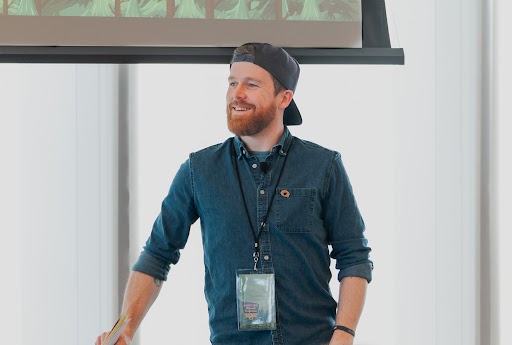
Eric Steigerwald
STEIGERWALD: I grew up in Cleveland, Ohio without much of a “magical” background. I remember seeing magic from time to time and the occasional library book – but nothing that sparked major interest in pursuing it more and more. I was truly sparked by OHM through a friend of a friend, performing magic for me at a bar and blowing me away directly in front of me. I learned about the mission of OHM and immediately thought, “If I’m having this reaction … I can’t imagine what a kid feels being a part of the
magic in a hospital room.”
Lexi Gallopoulos
GALLOPOULOS: I grew up in the Chicago area and outside of D.C., and then bopped around a bit. When I moved back to Chicago, I wanted to find an organization where I could volunteer and meet cool people. After a quick google search for a way to help kids in hospitals (an area I’ve always been passionate about), I found OHM and fell in love with the work. It sounded amazing to be able to help hospitalized kids feel less scared, laugh for the first time, and regain a sense of control during an incredibly difficult time. I was also very impressed by the intense training (Magic University) that OHM created and provided, and how they made a point of making sure volunteers ask before leaving a kid’s hospital room whether they would like their door open, half-open, or closed. It’s a small detail that means so much when you’re in a situation where you don’t have any control.
So, I decided to become a volunteer hospital magician (with zero prior magic experience) and in an unexpected but spectacular twist, I now also work at OHM as a staff member. It is truly an awesome experience and responsibility to be a part of the magic.

CCM: What is the one thing that you like most about being a part Open Heart Magic?
WALTON: The mesh between the importance of this work, working with kids in tough situations and the amazing people who are a part of OHM who transform these kids. They are the ones who make a child laugh again for the first time. They are truly the best people I know and their dedication is inspiring. OHM looks for amazing, committed people and most don’t know magic but they have to learn more than sleight of hand. They need to go through OHM’s Magic University and it’s not easy.
It takes a special person to become an OHM magician, so OHM ends up attracting remarkable people with all sorts of backgrounds, skills, and talents. It’s a unique community unlike any other – all driven with the same desire to help deliver critical laughs to sick kids.
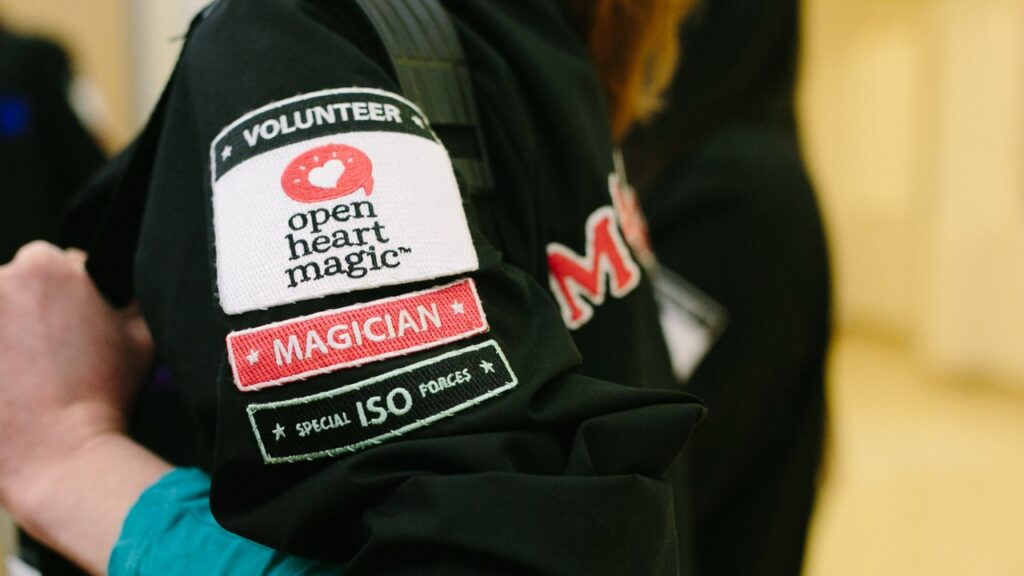
CCM: How many hospitals do you serve, and do you sometimes have nurses and other staff wanting to learn magic.
STEIGERWALD: We currently have 12 hospital partners, across 3 different states – Illinois, Michigan, and Ohio. And even though the Bedside Magic® program was designed to work one-on-one at a young patient’s bedside, we have found – especially post-COVID-how invaluable the magic is for hospital staff as well. We always defer to nurses, doctors, and other staff in the patient’s room, but it is more often than not that the doctors or nurses will allow us to take control of the room, to begin the bedside magic show to engage the child in something other than her treatment. Nurses will pull volunteers into rooms that they need to take blood in, or administer breathing tubes – and the magic is a perfect distraction. Doctors have made sure volunteers work with patients prior to surgeries or tests, so kids can have a magic wand and some hope to hold onto during.
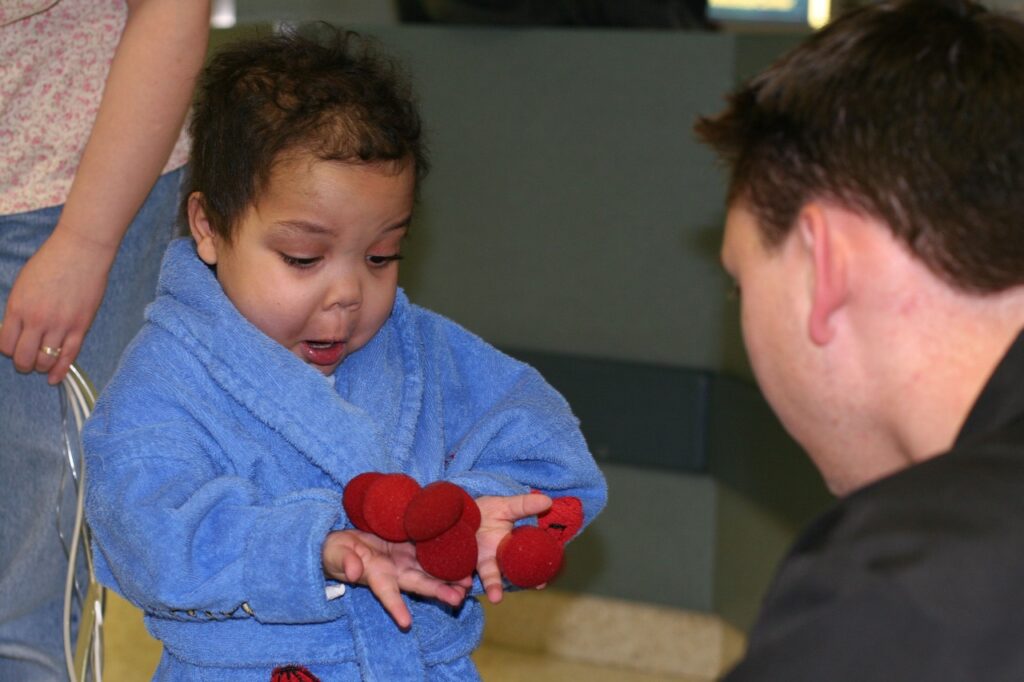
I think nurses and hospital staff are more interested in having magicians perform for their patients but knowing the stresses in the hospital and the heroes these nurses, hospital and Child Life staff members are, our volunteers will often do a quick trick for them to get a smile.
CCM: The name of your organization is just so wonderful.
WALTON: I wanted this to be something powerful for the kids. The name Open Heart Magic comes from the idea of opening your heart to these kids. Volunteers, donors, charity team runners can all be a part in an effort to help kids. I started doing magic simply to volunteer. I knew some close up magic which is more intimate and about creating an amazing experience between two or three people and thought this could be something great for kids. It’s not that typical child party magic but something meant to transform someone from the experience.
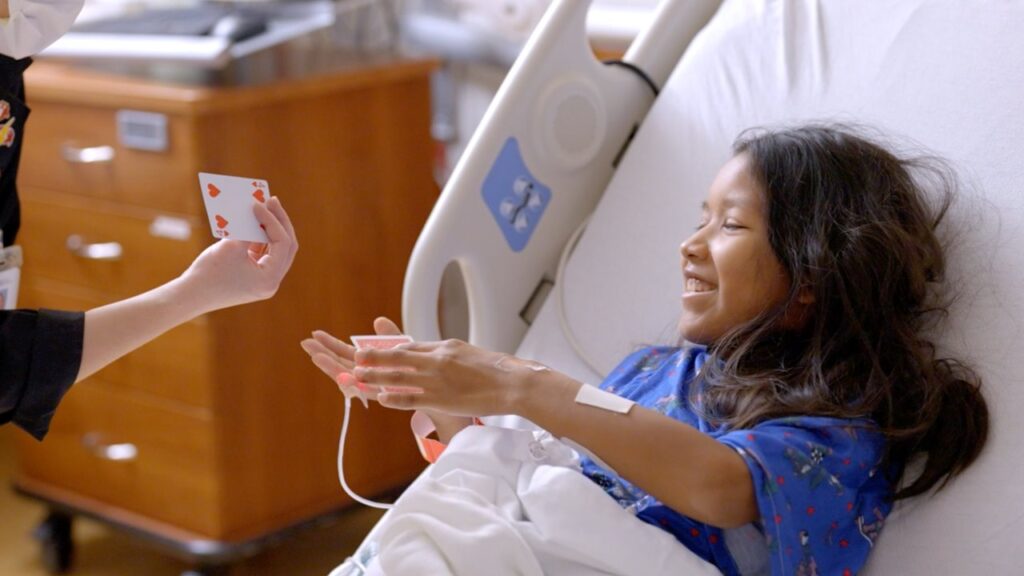
CCM: Is there a favorite trick among the kids? Do you have a favorite trick?
STEIGERWALD: My favorite trick – the best trick – is the one that creates a tiny laugh in the toughest of situations. Our goal is to
meet sick kids where they are, safely at their hospital bedside as some fight for their lives. It’s an incredible privilege to work with kids and families during this time, at such a vulnerable place. Being able to read the room, interact at their level, and transform a child’s emotional state with any magic trick is indescribable. To watch a child’s face go from fear, pain, and uncertainty to hope,
joy, and laughter is magical.
CCM: As a magician, what are the important abilities you need to have? What do you look for in volunteers?
STEIGERWALD: Volunteers do not need magic experience. We look for volunteers who are interesting, charismatic, dedicated, and have a passion to learn and bring magic to kids. Because OHM’s number one rule is to do no harm. And because the hospital environment is so unique – with protocols being absolutely critical– volunteers must be able to follow instructions clearly and succinctly, there is no room for misinterpretation. OHM has strict guidelines and evaluations, along with extremely high expectations, to ensure that our volunteers are able to meet kids safely at their hospital bedside and create this amazing experience for them even in the toughest and most sensitive medical environments.
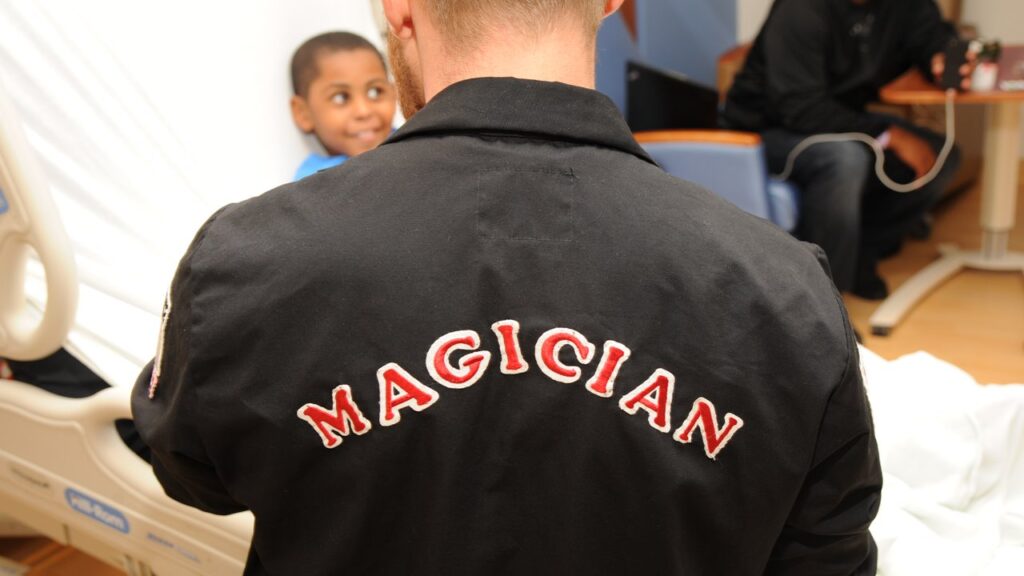
CCM: How do the kids react to learning magic?
GALLOPOULOS: As we’re doing magic with kids, they of course want to know how it works. So we provide Secret Lessons, where during our interaction with a kid, we teach them how to do a magic trick, step-by-step. It’s so incredibly fun, first everyone knows that a magician doesn’t reveal their tricks – unless someone is clearly very magical (as all the kids we work with are). So, before we teach a trick we start everything off with quite a few giggles as the kiddo takes the Magician’s Oath. Then, we’ll often perform a Secret Lesson first, and then break it down – it’s great to see the light bulb go off, and the eyes open up wide – you can see the kid realizing how something works. Then when they try it, there is such pride, they want to show every person who comes into the hospital room their magic trick, often they’ll share it with siblings and friends who visit in thhospital.
e We’ve also heard from parents that upon going back to school, they’re kids often get inundated with questions about their hospital stay, and they’re able to say “I learned magic” and show their peers something fun and new they learned, rather than re-visiting the anxiety that came along with their time in the hospital.
CCM: Can very young children learn magic tricks? Do they share with siblings and friends?
GALLOPOULOS: In general we work with kids ages 4 and up—it can go into early 20s depending on the hospital– and we make sure that every Open Heart Magic Magician is able to tailor their magic and interaction not only to a patient’s situation, but also to their age. So yes, we definitely work with young kids. Moreover, if they’re loved ones in the room, we make sure to include the them: everyone gets to learn a trick and partake in the magic. I’ve even had kids ask to facetime their sibling so they can be a part of the magic too – which is great!
CCM: What does seeing magic accomplish? It must take the kids to a whole new world.
WALTON: Magic is powerful in the hospital environment with kids for several reasons. The first is that being offered magic is such a strong hook – it gets a kid’s attention. Kids who have lost a sense of control of their schedule and life will try to regain that control in a hospital room by saying “no” to anything offered, understandably. But with magic, they look at you with a smile and let you in and the interaction builds immediate rapport and interest. Having that interest is key to engaging a child and getting them to laugh, which is the next super power of magic within a hospital.
Laughter is absolutely the best medicine for the patient and the child. We focus on very interactive magic with much of it happening in a child’s or teen’s hands so it’s extra spellbinding. When the magic is so strong it’s surprising, kids can’t help but laugh and be transformed. Once a parent told me when I walked in to see his teenage son, “Good luck. Go ahead and try…” as you could tell it was a rough day for the teen and family. The magic engaged the teen and the surprise caused him to swear in front of his Mom and everyone laughed and she was relieved to see him act like he used to act before his disease.

Finally magic speaks to all ages, demographics, economic backgrounds and cultures. It doesn’t matter who is in the room – that child and family when they hear magic and ready to go and experience something that is focused on the child feeling like a child again with laughter and courage rather than a child with a medical problem that everyone in the hospital is trying to rightfully fix. From a teenager in a gang on the south side of Chicago to the most difficult four year old who is scared and being held by his mom, any young patient can connect to this experience and the feeling that the magician is there to support him or her and make sure they’re going to have a fun time. This helps reduce stress and helps everyone no matter their situation.
CCM: Where can one learn magic, where do your volunteers learn?
WALTON: All applicants go through a rigorous screening, testing and certification process with a series of tests called Magic University. Not everyone who applies to volunteer is invited to training, and not everyone who starts training successfully completes it. Being a Hospital Magician Volunteer, and helping sick kids get their magic back, is not for everyone. The magic we teach and, just as important, the protocol we teach is critical to delivering joy and laughter to kids at their hospital bedside. We teach the hospital protocols such as infection control and go through many different scenarios such as what to do if a child has a seizure when you’re working with them in neurology or when to press the nurse’s call button and say “Nurse, come here now!”
It can be an intense but exciting environment and definitely a meaningful one. We want to make sure they can handle any situation that is presented with grace and still be effective in helping a child and their family. We teach our volunteers over the course of an 11-week intensive training, with opportunities for on-going continuing education during their lifespan as a volunteer.
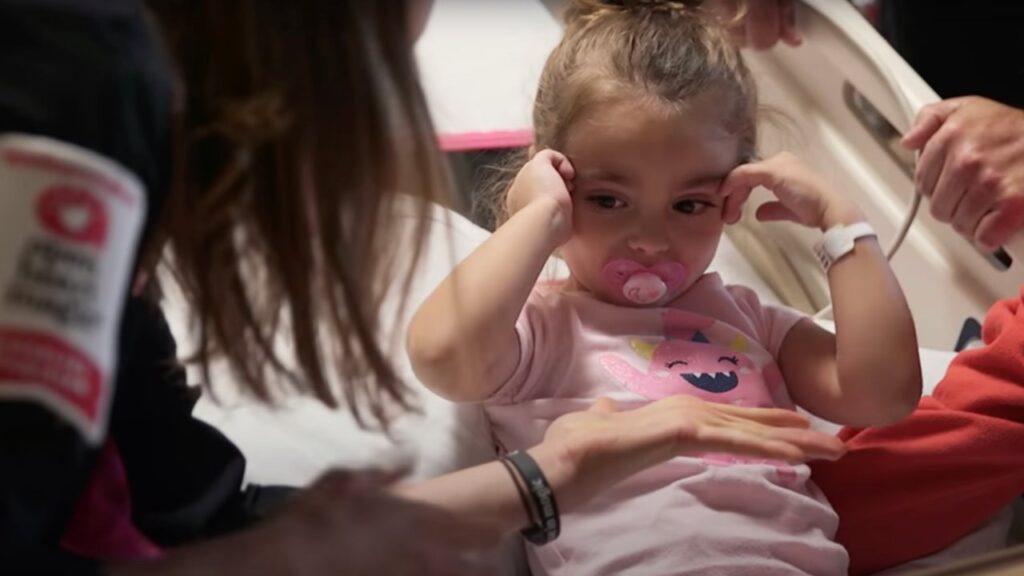
CCM: What is unique about Open Heart Magic and what changes have you seen in the children you meet?
WALTON: I think several things set OHM apart from other nonprofits. From its start, I wanted to make sure we were there for kids during that critical time they were working to get better, on the front lines no matter where they were at, at the time. I learned early on from a situation with a 12-year-old boy in pediatric intensive care who couldn’t move his arms, legs or speak but his parents asked me to visit. I had the boy blink to choose a card as I dribbled the deck into my other hand then the child blinked twice to do the magic so he could still be a part and it could still be meaningful for him. The parents asked me back the following week.
Since then it was clear to me that we needed to go into the toughest, most sensitive rooms – the rooms where most volunteers can’t go. So, we created a rigorous training and testing protocol, called Magic University (Magic U.). During Magic U., we train potential OHM magicians to not only understand a wide variety of situations they may encounter, but they are
Confidence allows OHM magicians the opportunity to be themselves and create fun in the room while knowing they can keep kids safe and engaged in any situation. Magic U. covers how to teach magic, how to be safe and effective, and, this may be the most important – how to reach a child and their family where they’re at mentally, emotionally and physically with any limitations they may have. For example, I was asked by a doctor to visit a young boy by himself in intensive care. It seemed like he was in shock.
There’s a process to engage a child, which starts by mirroring their energy. In this case, I started slowly by offering him a red silk and seeing if he would take it. When he did, I started to engage a bit more by asking him questions, and then as he got more comfortable, I had him do the magic (I was just there to help) by having him wave his hand around which made the red silk disappear and reappear. The back and forth brought him out of this sense of isolation and he sat up and was more engaged. I later found out that he was in his car accident and lost his family. The hospital is filled with tough cases like this. I wanted the best quality people, with the most intense training to replicate the success I had in front of kids in any situation in a children’s hospital. I feel we’re there and am proud of everyone who comes together to make this happen. The people and this approach also set OHM apart from other organizations. The term volunteer doesn’t accurately describe the quality nor commitment of the people who are seeing the kids and the training they receive. Hospitals have asked us about what we do to train our folks. It’s all part of it. An important part of it.

CCM: Any future plans for Open Heart Magic?
WALTON: There are kids in Chicago, Ann Arbor and Cleveland that we’re not seeing and we’re working to raise money so that we can grow and see these kids that are being missed. We’re hoping to triple the number of kids we see at their bedsides over the next three years.
And we’re looking to expand to the next city. When we go to a city, we don’t think in terms of seeing a few kids. We think in terms of what children’s hospitals are in the area and how we can bring our Bedside Magic® program to kids that are experiencing scary medical situations at all of the children’s hospitals in a region. We’re currently looking to Family Offices, philanthropists and potential business partners to find someone who is interested in bringing this legacy project to the kids and families of a large city like Baltimore, Philadelphia, Los Angeles, New York or who knows Boston. Nothing is set as we’re focusing on local growth now. But this bedside magic interaction works and transforms kids. It’s time to build something sustainable and lasting that will benefit kids at that critical time when they’re working to turn the corner with their disease.
CCM: Anything else you’d like to share about OHM, magic, or your experience with the kids?
WALTON: Open Heart Magic is more than just very important volunteers and staff. It truly is a community of those in that city who are committed and coming together to bring magic to the kids. We’ve figured out how to allow a donor to bring a magic show to a patient for a few dollars per room. We have an amazing group of OHM Charity Team runners who run the Chicago and Berlin marathons and fund-raise to grow Bedside Magic to more kids. We have a Board who leads this organization and brings tremendous resources to the programs to reach more kids. All of these wheels are critical to keep this bus moving forward and we’re always looking for those who want to help so we can continue to grow and see the kids we’re missing right now.

For further information about Open Heart Magic, visit:
openheartmagic.org



